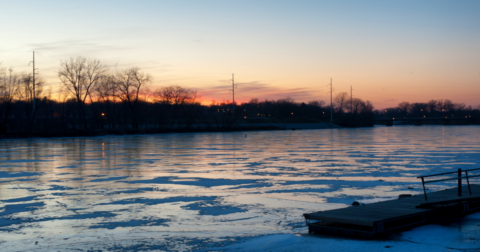Explainer
Agriculture Affects Deforestation Much More Than Most People Realize
Climate•7 min read
News
Iowa clean water advocates criticized the EPA’s move to reverse a decision adding seven Iowa river segments to the state’s impaired waters list.


Words by Gaea Cabico
When the U.S. Environmental Protection Agency added seven Iowa river segments to the state’s impaired waters list last year, Linda Fitzgerald thought it would be a meaningful step toward addressing water pollution. The self-described “fifth-generation river rat” has seen local waterways become more polluted and the proliferation of factory farms in the state. “It really looked like we were getting somewhere,” Fitzgerald, who is also a member of Iowa Citizens for Community Improvement, tells Sentient. But for Fitzgerald and other Iowa clean water advocates, that progress was upended July 11.
The EPA rescinded its November 2024 order to add the seven river segments, which means stretches of the Cedar, Des Moines, Iowa, Raccoon and South Skunk rivers in Iowa will no longer be classified as “impaired.” In effect, these rivers are no longer treated as exceeding the EPA’s standard for nitrate levels in groundwater. The decision removes the requirement for cleanup plans under the Clean Water Act and reduces federal scrutiny of these Iowa waters.
Under the Clean Water Act, states must update and submit a list of “impaired” rivers, streams and lakes that are polluted or at risk to the EPA every two years. Once a water body is added to the list, it remains there until the EPA approves the state’s plan to reduce pollution. Even after that cleanup plan is in place and the water is no longer considered impaired, the state continues to track it until the water body is fully restored.
The EPA’s reversal on adding the seven Iowa river segments comes after Central Iowa Water Works, a regional collective of water utilities, issued a first-ever lawn watering ban, in response to high levels of nitrates in the Des Moines and Raccoon rivers, two key water sources for central Iowa. The restrictions were lifted on August 15.
High nitrate concentrations are driven in part by agriculture in Iowa, where livestock operations produce 109 billion pounds of manure each year. Fertilizer runoff from both synthetic nitrogen fertilizers and livestock manure washes excess nitrogen into rivers, streams and groundwater.
Elevated levels of nitrogen and phosphorus from fertilizers and livestock manure also contribute to harmful algae blooms, especially in spring and summer, and threaten wildlife. Between 2013 and 2023, manure spills from factory farms in the state killed nearly two million fish.
Fitzgerald had hoped that designating these rivers as impaired would push the state to acknowledge that nitrate pollution in Iowa’s waters comes largely from industrial agriculture — waste from hog farms, excessive fertilizer use and widespread tile drainage, which refer to a network of underground engineering mechanisms that remove excess water, making Iowa soils especially fertile. “Just admitting that the source is ag and having to come up with a more effective reduction strategy would be a big win,” she later told Sentient in an email.
In 2024, Iowa’s Department of Natural Resources submitted a list that included 577 water bodies, with 746 impairments, based on data from 2020 to 2022, excluding the seven river segments.
At the time, environmental groups argued the list was not representative of the full scope of water pollution in Iowa, especially since it was based on data from drought years with unusually low nitrate levels. In its November 2024 decision — the one it later reversed — the EPA said nitrate concentrations in the seven water sources exceeded safe drinking water standards and added them to the list.
But in a July 11 letter to the Iowa Department of Natural Resources, James Macy, who heads EPA Region 7 — which covers much of the Midwest — wrote that the agency was reversing its earlier decision to review the new information provided by the DNR. Macy wrote that “the EPA is rescinding its partial disapproval and identification of the referenced seven waters so that it can further evaluate this rationale and reconsider its decision.”
Iowa Environment Council general counsel Michael Schmidt tells Sentient that delisting could undermine efforts to clean up these waterways, especially amid funding cuts for water monitoring. “Removing them from the impaired waters list suggests we don’t need to worry about them because they’re meeting the standards and everything is fine,” he says.
The rollback did not surprise Fitzgerald, but it did leave her disappointed, “especially having felt like maybe we made an impact and maybe something good was going to come out of it.”
High levels of nitrate in drinking water can be dangerous. Consuming excessive nitrates can cause methemoglobinemia — or “blue baby syndrome” — which reduces the blood’s ability to carry oxygen, especially in infants. Research has also linked nitrates in drinking water to a higher risk of other conditions, including thyroid disease and cancer.
Iowa has the fastest-growing rate of new cancers in the country and the second-highest incidence rate after Kentucky, according to a 2024 report by the Iowa Cancer Registry. The report highlighted alcohol and binge drinking as cancer risks, but did not mention agriculture as a potential contributing factor.
Fitzgerald says cancer is so widespread, that it would be hard to find anyone in Iowa who has not been affected by cancer or Parkinson’s, either personally or through a family member. Fitzgerald herself was diagnosed with aggressive breast cancer in her early 30s, and more recently with a bone marrow abnormality.
EPA’s legal limit for nitrate in drinking water is 10 milligrams per liter. Fitzgerald, who conducts citizen water testing in Cedar River, says she often finds nitrate levels at or above the EPA limit, especially in areas where farmlands drain or after a heavy rain. Citizen testing does have limits: handheld kits and strips are less precise than laboratory methods, and factors like water flow or temperature can affect readings.
While Des Moines Water Works operates one of the world’s largest nitrate removal facilities, 96 percent of Iowa’s drinking water providers lack any treatment system to remove nitrate, according to the Iowa Environmental Council.
Removing Iowa waters from the impaired list is “misguided,” Schmidt said in a press release, adding that the decision erodes public trust in agencies meant to protect clean water. In an interview with Sentient, Schmidt says the state should enforce reduced fertilizer use and improve manure application to address nitrate pollution in Iowa’s waters.
Fitzgerald would like to see a bigger change. “Both of those organizations just need to have a complete overhaul before they can actually be effective. One of the things they might focus on is trying to get the polluters to pay for their pollution,” she says. Still, she’s not optimistic at the moment. “With those regulators in charge, it’s not going to happen.”